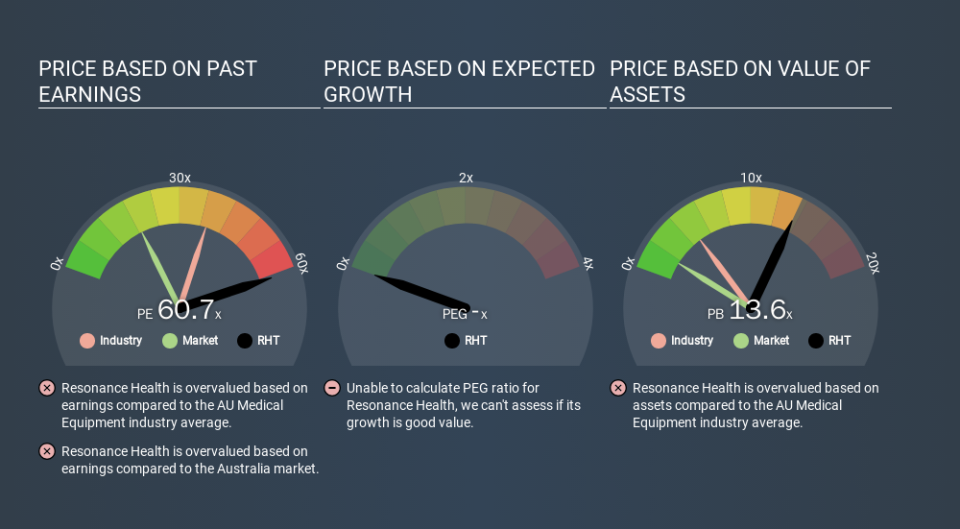What Is Resonance Health's (ASX:RHT) P/E Ratio After Its Share Price Rocketed?

Resonance Health (ASX:RHT) shares have continued recent momentum with a 46% gain in the last month alone. Zooming out, the stock's 660% gain in the last year is certainly splendiferous.
Assuming no other changes, a sharply higher share price makes a stock less attractive to potential buyers. In the long term, share prices tend to follow earnings per share, but in the short term prices bounce around in response to short term factors (which are not always obvious). So some would prefer to hold off buying when there is a lot of optimism towards a stock. One way to gauge market expectations of a stock is to look at its Price to Earnings Ratio (PE Ratio). A high P/E ratio means that investors have a high expectation about future growth, while a low P/E ratio means they have low expectations about future growth.
See our latest analysis for Resonance Health
Does Resonance Health Have A Relatively High Or Low P/E For Its Industry?
We can tell from its P/E ratio of 60.72 that there is some investor optimism about Resonance Health. You can see in the image below that the average P/E (37.7) for companies in the medical equipment industry is lower than Resonance Health's P/E.
Its relatively high P/E ratio indicates that Resonance Health shareholders think it will perform better than other companies in its industry classification. Clearly the market expects growth, but it isn't guaranteed. So investors should delve deeper. I like to check if company insiders have been buying or selling.
How Growth Rates Impact P/E Ratios
Earnings growth rates have a big influence on P/E ratios. That's because companies that grow earnings per share quickly will rapidly increase the 'E' in the equation. That means unless the share price increases, the P/E will reduce in a few years. Then, a lower P/E should attract more buyers, pushing the share price up.
Resonance Health's 461% EPS improvement over the last year was like bamboo growth after rain; rapid and impressive.
Don't Forget: The P/E Does Not Account For Debt or Bank Deposits
Don't forget that the P/E ratio considers market capitalization. So it won't reflect the advantage of cash, or disadvantage of debt. Theoretically, a business can improve its earnings (and produce a lower P/E in the future) by investing in growth. That means taking on debt (or spending its cash).
Such spending might be good or bad, overall, but the key point here is that you need to look at debt to understand the P/E ratio in context.
How Does Resonance Health's Debt Impact Its P/E Ratio?
Resonance Health has net cash of AU$3.1m. That should lead to a higher P/E than if it did have debt, because its strong balance sheets gives it more options.
The Verdict On Resonance Health's P/E Ratio
Resonance Health's P/E is 60.7 which suggests the market is more focussed on the future opportunity rather than the current level of earnings. The excess cash it carries is the gravy on top its fast EPS growth. To us, this is the sort of company that we would expect to carry an above average price tag (relative to earnings). What we know for sure is that investors have become much more excited about Resonance Health recently, since they have pushed its P/E ratio from 41.5 to 60.7 over the last month. If you like to buy stocks that have recently impressed the market, then this one might be a candidate; but if you prefer to invest when there is 'blood in the streets', then you may feel the opportunity has passed.
When the market is wrong about a stock, it gives savvy investors an opportunity. People often underestimate remarkable growth -- so investors can make money when fast growth is not fully appreciated. We don't have analyst forecasts, but you might want to assess this data-rich visualization of earnings, revenue and cash flow.
Of course, you might find a fantastic investment by looking at a few good candidates. So take a peek at this free list of companies with modest (or no) debt, trading on a P/E below 20.
If you spot an error that warrants correction, please contact the editor at editorial-team@simplywallst.com. This article by Simply Wall St is general in nature. It does not constitute a recommendation to buy or sell any stock, and does not take account of your objectives, or your financial situation. Simply Wall St has no position in the stocks mentioned.
We aim to bring you long-term focused research analysis driven by fundamental data. Note that our analysis may not factor in the latest price-sensitive company announcements or qualitative material. Thank you for reading.

